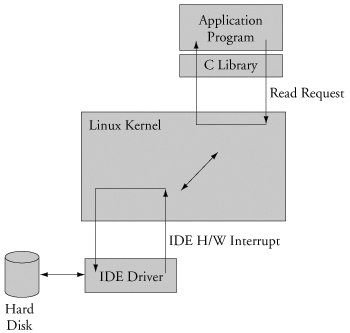Книга: Embedded Linux Primer: A Practical, Real-World Approach
2.3.6. Execution Contexts
2.3.6. Execution Contexts
One of the very first chores that Linux performs when it begins to run is to configure the hardware memory management unit (MMU) on the processor and the data structures used to support it, and to enable address translation. When this step is complete, the kernel runs in its own virtual memory space. The virtual kernel address selected by the kernel developers in recent versions defaults to 0xC0000000. In most architectures, this is a configurable parameter.[12] If we were to look at the kernel's symbol table, we would find kernel symbols linked at an address starting with 0xC0xxxxxx. As a result, any time the kernel is executing code in kernel space, the instruction pointer of the processor will contain values in this range.
In Linux, we refer to two distinctly separate operational contexts, based on the environment in which a given thread[13] is executing. Threads executing entirely within the kernel are said to be operating in kernel context, while application programs are said to operate in user space context. A user space process can access only memory it owns, and uses kernel system calls to access privileged resources such as file and device I/O. An example might make this more clear.
Consider an application that opens a file and issues a read request (see Figure 2-6). The read function call begins in user space, in the C library read() function. The C library then issues a read request to the kernel. The read request results in a context switch from the user's program to the kernel, to service the request for the file's data. Inside the kernel, the read request results in a hard-drive access requesting the sectors containing the file's data.
Figure 2-6. Simple file read request

Usually the hard-drive read is issued asynchronously to the hardware itself. That is, the request is posted to the hardware, and when the data is ready, the hardware interrupts the processor. The application program waiting for the data is blocked on a wait queue until the data is available. Later, when the hard disk has the data ready, it posts a hardware interrupt. (This description is intentionally simplified for the purposes of this illustration.) When the kernel receives the hardware interrupt, it suspends whatever process was executing and proceeds to read the waiting data from the drive. This is an example of a thread of execution operating in kernel context.
To summarize this discussion, we have identified two general execution contexts, user space and kernel space. When an application program executes a system call that results in a context switch and enters the kernel, it is executing kernel code on behalf of a process. You will often hear this referred to as process context within the kernel. In contrast, the interrupt service routine (ISR) handling the IDE drive (or any other ISR, for that matter) is kernel code that is not executing on behalf of any particular process. Several limitations exist in this operational context, including the limitation that the ISR cannot block (sleep) or call any kernel functions that might result in blocking. For further reading on these concepts, consult Section 2.5.1, "Suggestions for Additional Reading," at the end of this chapter.




